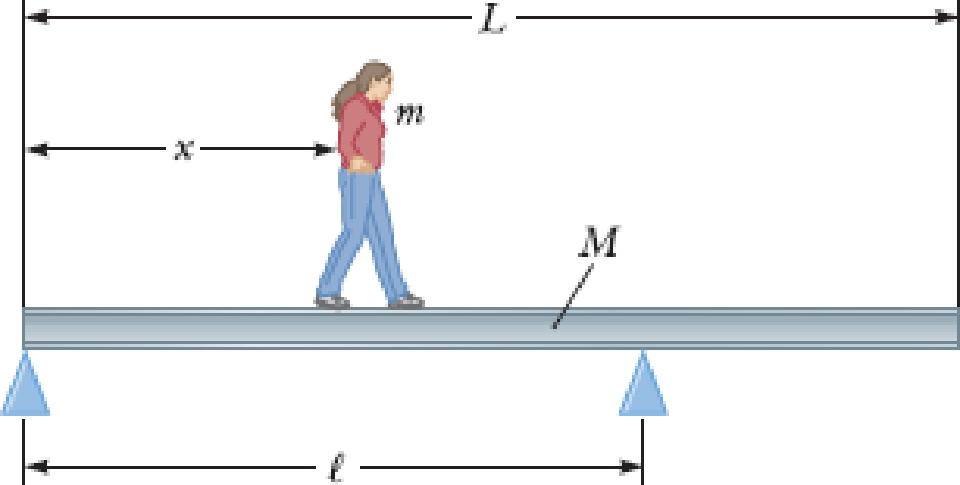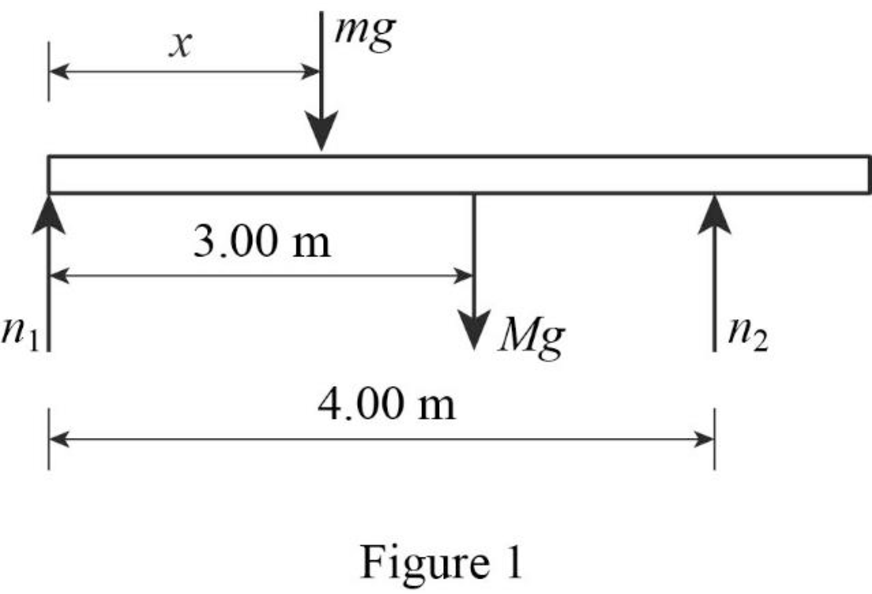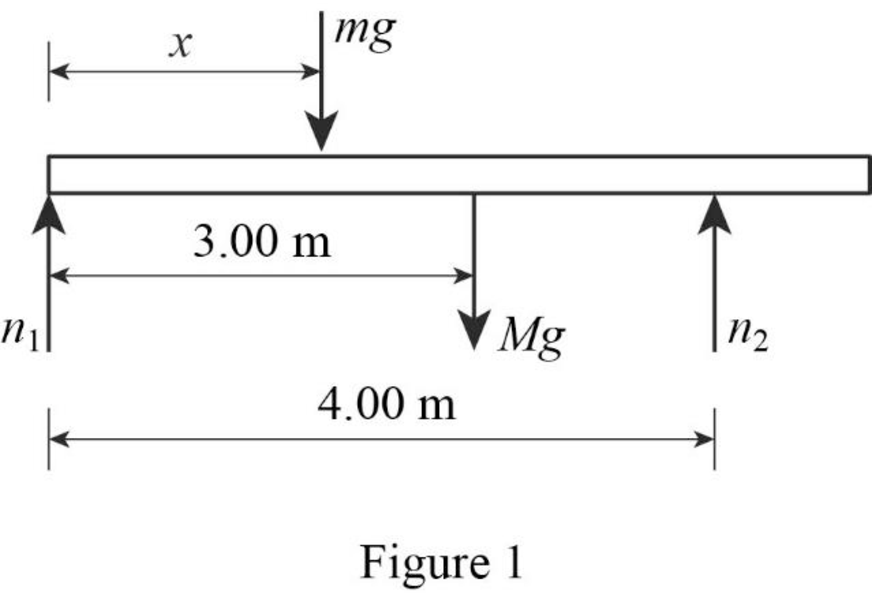
Concept explainers
A uniform beam resting on two pivots has a length L = 6.00 m and mass M = 90.0 kg. The pivot under the left end exerts a normal force n1 on the beam, and the second pivot located a distance ℓ = 4.00 m from the left end exerts a normal force n2. A woman of mass m = 55.0 kg steps onto the left end of the beam and begins walking to the right as in Figure P10.28. The goal is to find the woman’s position when the beam begins to tip. (a) What is the appropriate analysis model for the beam before it begins to tip? (b) Sketch a force diagram for the beam, labeling the gravitational and normal forces acting on the beam and placing the woman a distance x to the right of the first pivot, which is the origin. (c) Where is the woman when the normal force n1 is the greatest? (d) What is n1 when the beam is about to tip? (e) Use Equation 10.27 to find the value of n2 when the beam is about to tip. (f) Using the result of part (d) and Equation 10.28, with torques computed around the second pivot, find the woman’s position x when the beam is about to tip. (g) Check the answer to part (e) by computing torques around the first pivot point.
Figure P10.28

(a)
The model of beam used for analysis before it begins to tip.
Answer to Problem 28P
The object is in static equilibrium before it begins to tip.
Explanation of Solution
Initially the beam is balanced. When an object is at rest the equilibrium maintained by the object is called static equilibrium.
Hence the object is in static equilibrium before it begins to tip.
Conclusion:
Therefore, the object is in static equilibrium before it begins to tip.
(b)
Sketch the force diagram for the beam.
Answer to Problem 28P
The force diagram of the beam is given below.

Explanation of Solution
Force diagram represents all the different kinds of forces acting on the given system. Weight of the women,
Conclusion:
The weight of the women is.
Here,
The weight of the beam corresponding to center of mass is.
Substitute,
Substitute,
The force diagram of the beam is given below.

(c)
The position of the women when the normal force is greatest.
Answer to Problem 28P
When the women is at
Explanation of Solution
The normal force
The normal force
Conclusion:
Therefore, the normal force
(d)
The value of
Answer to Problem 28P
The value of
Explanation of Solution
When the women walk from left end to right end she will reach at a point so that the beam start to rotate in clockwise direction about the right pivot. So the beam starts to lift up about the leftmost pivot, thus the normal force exerted by the pivot will be zero.
Thus the normal force
Conclusion:
Therefore, the value of
(e)
The value of
Answer to Problem 28P
The value of
Explanation of Solution
Write the expression for the total force acting on
Since the force exerted on beam, and normal force
Rearrange equation (IV) to obtain an expression for
Conclusion:
Substitute,
Therefore, value of
(f)
The position of women when the beam is about to tip.
Answer to Problem 28P
The position of women when the beam is about to tip is
Explanation of Solution
Write the expression for total torque in the beam.
When the beam is about to the tip, the torque
Substitute,
Conclusion:
Substitute,
Therefore, the position of women when the beam is about to tip is
(g)
To check the answer in part (f) computing the torque around the first pivot point.
Answer to Problem 28P
The position of the women is
Explanation of Solution
Write the expression for the net torque about the left pivot.
Conclusion:
The net torque about the left pivot is zero.
Substitute,
The position obtained in part (f) is
Therefore, the position of the women is
Want to see more full solutions like this?
Chapter 10 Solutions
Principles of Physics: A Calculus-Based Text
- 20. Two small conducting spheres are placed on top of insulating pads. The 3.7 × 10-10 C sphere is fixed whie the 3.0 × 107 C sphere, initially at rest, is free to move. The mass of each sphere is 0.09 kg. If the spheres are initially 0.10 m apart, how fast will the sphere be moving when they are 1.5 m apart?arrow_forwardpls help on allarrow_forwardpls help on thesearrow_forward
- pls help on all asked questions kindlyarrow_forwardpls help on all asked questions kindlyarrow_forward19. Mount Everest, Earth's highest mountain above sea level, has a peak of 8849 m above sea level. Assume that sea level defines the height of Earth's surface. (re = 6.38 × 106 m, ME = 5.98 × 1024 kg, G = 6.67 × 10 -11 Nm²/kg²) a. Calculate the strength of Earth's gravitational field at a point at the peak of Mount Everest. b. What is the ratio of the strength of Earth's gravitational field at a point 644416m below the surface of the Earth to a point at the top of Mount Everest? C. A tourist watching the sunrise on top of Mount Everest observes a satellite orbiting Earth at an altitude 3580 km above his position. Determine the speed of the satellite.arrow_forward
- pls help on allarrow_forwardpls help on allarrow_forward6. As the distance between two charges decreases, the magnitude of the electric potential energy of the two-charge system: a) Always increases b) Always decreases c) Increases if the charges have the same sign, decreases if they have the opposite signs d) Increases if the charges have the opposite sign, decreases if they have the same sign 7. To analyze the motion of an elastic collision between two charged particles we use conservation of & a) Energy, Velocity b) Momentum, Force c) Mass, Momentum d) Energy, Momentum e) Kinetic Energy, Potential Energyarrow_forward
 Principles of Physics: A Calculus-Based TextPhysicsISBN:9781133104261Author:Raymond A. Serway, John W. JewettPublisher:Cengage Learning
Principles of Physics: A Calculus-Based TextPhysicsISBN:9781133104261Author:Raymond A. Serway, John W. JewettPublisher:Cengage Learning Glencoe Physics: Principles and Problems, Student...PhysicsISBN:9780078807213Author:Paul W. ZitzewitzPublisher:Glencoe/McGraw-Hill
Glencoe Physics: Principles and Problems, Student...PhysicsISBN:9780078807213Author:Paul W. ZitzewitzPublisher:Glencoe/McGraw-Hill Physics for Scientists and Engineers: Foundations...PhysicsISBN:9781133939146Author:Katz, Debora M.Publisher:Cengage Learning
Physics for Scientists and Engineers: Foundations...PhysicsISBN:9781133939146Author:Katz, Debora M.Publisher:Cengage Learning Physics for Scientists and Engineers, Technology ...PhysicsISBN:9781305116399Author:Raymond A. Serway, John W. JewettPublisher:Cengage Learning
Physics for Scientists and Engineers, Technology ...PhysicsISBN:9781305116399Author:Raymond A. Serway, John W. JewettPublisher:Cengage Learning College PhysicsPhysicsISBN:9781938168000Author:Paul Peter Urone, Roger HinrichsPublisher:OpenStax College
College PhysicsPhysicsISBN:9781938168000Author:Paul Peter Urone, Roger HinrichsPublisher:OpenStax College Physics for Scientists and EngineersPhysicsISBN:9781337553278Author:Raymond A. Serway, John W. JewettPublisher:Cengage Learning
Physics for Scientists and EngineersPhysicsISBN:9781337553278Author:Raymond A. Serway, John W. JewettPublisher:Cengage Learning





